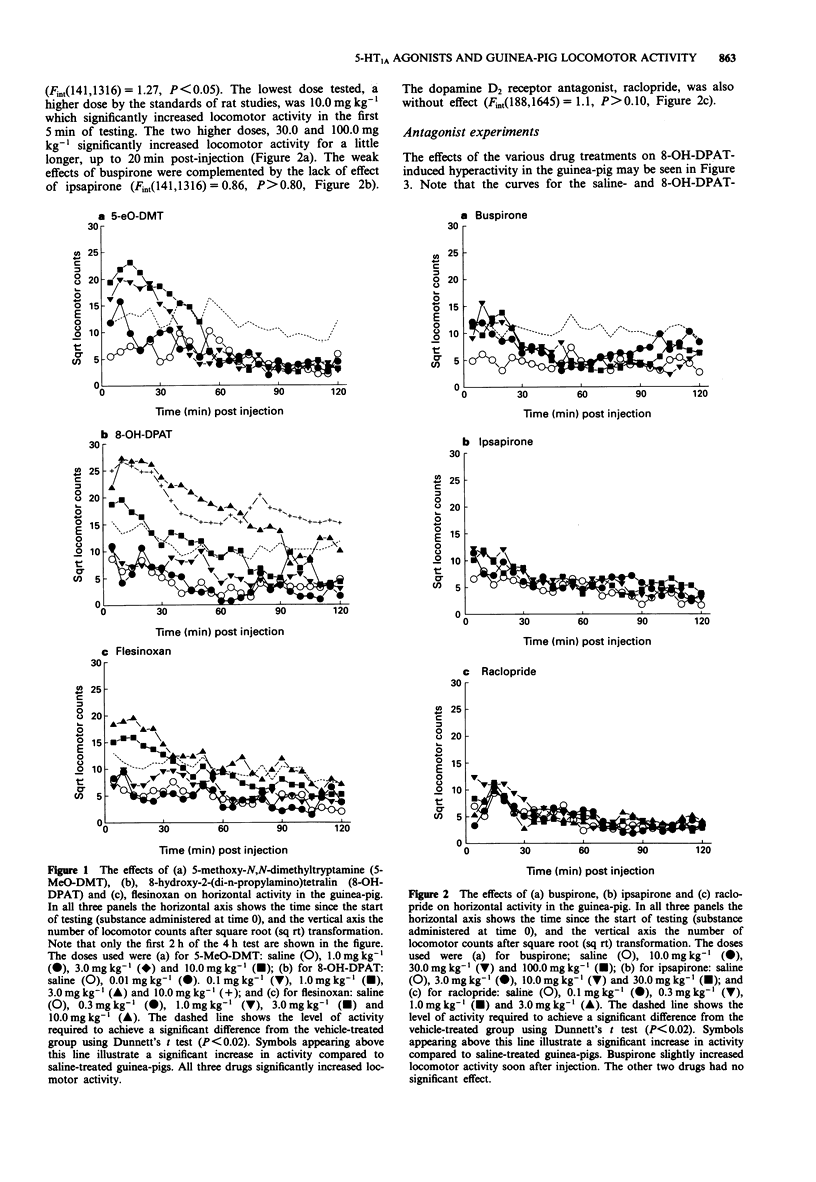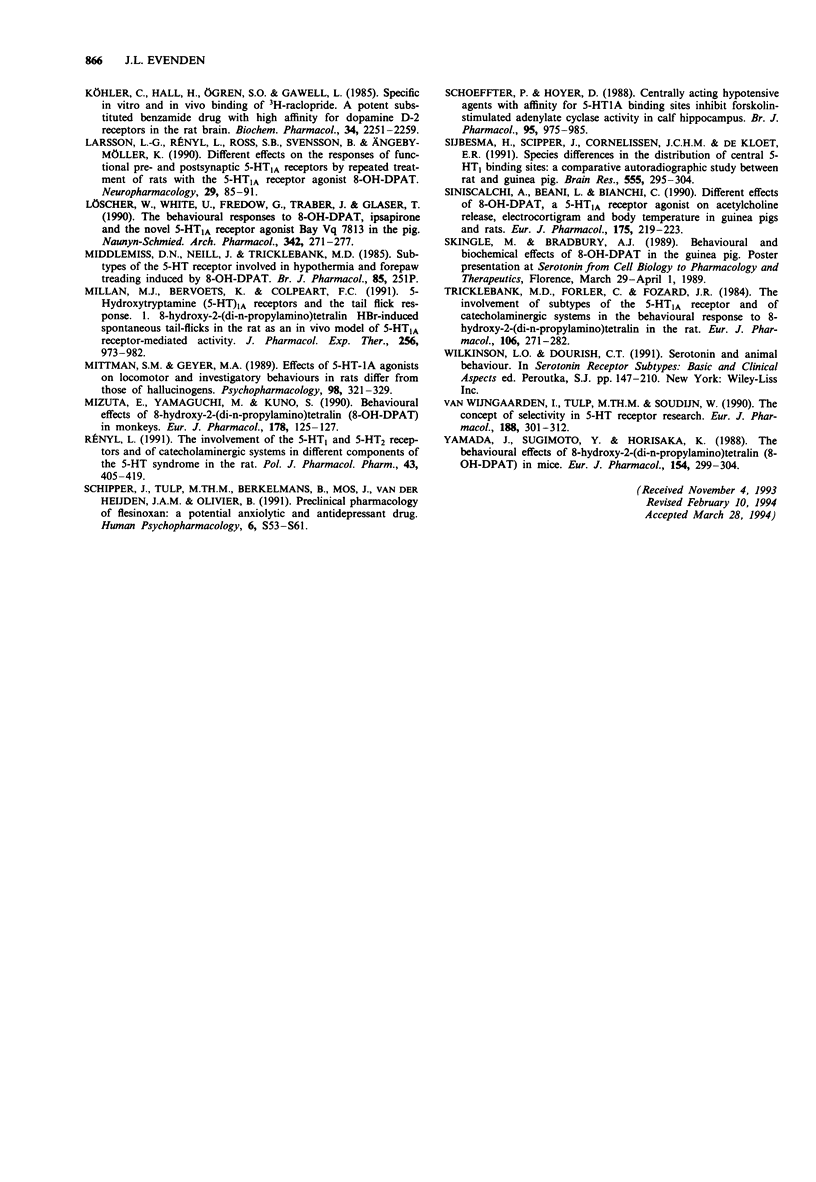Abstract
1. The present study examined the effects of 8-hydroxy-2-(di-n-propylamino) tetralin (8-OH-DPAT), flesinoxan, ipsapirone and buspirone, all agonists at the 5-HT1A receptor, on the locomotor activity of guinea-pigs. The effects of these drugs were contrasted with those of the non-selective 5-HT agonist, 5-methoxy-N,N-dimethyl tryptamine (5-MeO-DMT) and the dopamine D2 antagonist, raclopride. 2. 8-OH-DPAT, flesinoxan and 5-MeO-DMT markedly increased the locomotor activity of naive, unhabituated guinea-pigs in a dose-dependent manner. Buspirone also did so, although to a lesser extent and for a shorter time. The doses at which this effect was seen were higher than those normally employed in rats. Ipsapirone and raclopride had no significant effects on locomotor activity. 3. The locomotor activity increasing effect of 1.0 mg kg-1 8-OH-DPAT was blocked by the selective 5-HT1A antagonist (S)-UH-301 (3.0 and 10.0 mg kg-1), but not by (-)-alprenolol (15.0 mg kg-1). Ipsapirone (30.0 mg kg-1) and raclopride (3.0 mg kg-1) antagonized 8-OH-DPAT-induced locomotor activity but only to a small extent. The 5-HT reuptake inhibitor, zimelidine (10.0 mg kg-1) had no effect. 4. The effect of the 5-HT1A agonists in the guinea-pig contrasts with the effects of 8-OH-DPAT on the locomotor activity of unhabituated rats and mice tested in the same apparatus, but are similar to the effects of 8-OH-DPAT on habituated rats, which show a low baseline of activity.(ABSTRACT TRUNCATED AT 250 WORDS)
Full text
PDF





Selected References
These references are in PubMed. This may not be the complete list of references from this article.
- Ahlers S. T., Weissman B. A., Barrett J. E. Antagonism studies with BMY-7378 and NAN-190: effects on 8-hydroxy-2-(di-n-propylamino)tetralin-induced increases in punished responding of pigeons. J Pharmacol Exp Ther. 1992 Feb;260(2):474–481. [PubMed] [Google Scholar]
- Bill D. J., Knight M., Forster E. A., Fletcher A. Direct evidence for an important species difference in the mechanism of 8-OH-DPAT-induced hypothermia. Br J Pharmacol. 1991 Aug;103(4):1857–1864. doi: 10.1111/j.1476-5381.1991.tb12342.x. [DOI] [PMC free article] [PubMed] [Google Scholar]
- Björk L., Cornfield L. J., Nelson D. L., Hillver S. E., Andén N. E., Lewander T., Hacksell U. Pharmacology of the novel 5-hydroxytryptamine1A receptor antagonist (S)-5-fluoro-8-hydroxy-2-(dipropylamino)tetralin: inhibition of (R)-8-hydroxy-2-(dipropylamino)tetralin-induced effects. J Pharmacol Exp Ther. 1991 Jul 1;258(1):58–65. [PubMed] [Google Scholar]
- Björk L., Fredriksson A., Hacksell U., Lewander T. Effects of (R)-8-OH-DPAT and the enantiomers of UH-301 on motor activities in the rat: antagonism of (R)-8-OH-DPAT-induced effects. Eur Neuropsychopharmacol. 1992 Jun;2(2):141–147. doi: 10.1016/0924-977x(92)90024-3. [DOI] [PubMed] [Google Scholar]
- Boddeke H. W., Fargin A., Raymond J. R., Schoeffter P., Hoyer D. Agonist/antagonist interactions with cloned human 5-HT1A receptors: variations in intrinsic activity studied in transfected HeLa cells. Naunyn Schmiedebergs Arch Pharmacol. 1992 Mar;345(3):257–263. doi: 10.1007/BF00168684. [DOI] [PubMed] [Google Scholar]
- Buhot M. C., Rage P., Segu L. Changes in exploratory behaviour of hamsters following treatment with 8-hydroxy-2-(di-n-propylamino)tetralin. Behav Brain Res. 1989 Nov 1;35(2):163–179. doi: 10.1016/s0166-4328(89)80117-2. [DOI] [PubMed] [Google Scholar]
- Caccia S., Conti I., Viganò G., Garattini S. 1-(2-Pyrimidinyl)-piperazine as active metabolite of buspirone in man and rat. Pharmacology. 1986;33(1):46–51. doi: 10.1159/000138199. [DOI] [PubMed] [Google Scholar]
- Dumuis A., Sebben M., Bockaert J. Pharmacology of 5-hydroxytryptamine-1A receptors which inhibit cAMP production in hippocampal and cortical neurons in primary culture. Mol Pharmacol. 1988 Feb;33(2):178–186. [PubMed] [Google Scholar]
- Ericson E., Samuelsson J., Ahlenius S. Photocell measurements of rat motor activity. A contribution to sensitivity and variation in behavioral observations. J Pharmacol Methods. 1991 Apr;25(2):111–122. doi: 10.1016/0160-5402(91)90002-m. [DOI] [PubMed] [Google Scholar]
- Evenden J. L., Angeby-Möller K. Effects of 8-hydroxy-2-(di-n-propylamino)tetralin (8-OH-DPAT) on locomotor activity and rearing of mice and rats. Psychopharmacology (Berl) 1990;102(4):485–491. doi: 10.1007/BF02247129. [DOI] [PubMed] [Google Scholar]
- Evenden J. L. Effects of 8-hydroxy-2-(di-n-propylamino)tetralin (8-OH-DPAT) after repeated administration on a conditioned avoidance response (CAR) in the rat. Psychopharmacology (Berl) 1992;109(1-2):134–144. doi: 10.1007/BF02245491. [DOI] [PubMed] [Google Scholar]
- Gleeson S., Barrett J. E. 5-HT1A agonist effects on punished responding of squirrel monkeys. Pharmacol Biochem Behav. 1990 Oct;37(2):335–337. doi: 10.1016/0091-3057(90)90344-h. [DOI] [PubMed] [Google Scholar]
- Goodwin G. M., Green A. R. A behavioural and biochemical study in mice and rats of putative selective agonists and antagonists for 5-HT1 and 5-HT2 receptors. Br J Pharmacol. 1985 Mar;84(3):743–753. doi: 10.1111/j.1476-5381.1985.tb16157.x. [DOI] [PMC free article] [PubMed] [Google Scholar]
- Hillegaart V., Wadenberg M. L., Ahlenius S. Effects of 8-OH-DPAT on motor activity in the rat. Pharmacol Biochem Behav. 1989 Mar;32(3):797–800. doi: 10.1016/0091-3057(89)90036-1. [DOI] [PubMed] [Google Scholar]
- Hoyer D., Middlemiss D. N. Species differences in the pharmacology of terminal 5-HT autoreceptors in mammalian brain. Trends Pharmacol Sci. 1989 Apr;10(4):130–132. doi: 10.1016/0165-6147(89)90159-4. [DOI] [PubMed] [Google Scholar]
- Kalkman H. O., Soar J. Determination of the 5-HT receptor subtype involved in 8-OH-DPAT-induced hyperlocomotion: potential difficulties arising from inadequate pharmacological tools. Eur J Pharmacol. 1990 Dec 4;191(3):383–390. doi: 10.1016/0014-2999(90)94172-t. [DOI] [PubMed] [Google Scholar]
- Köhler C., Hall H., Ogren S. O., Gawell L. Specific in vitro and in vivo binding of 3H-raclopride. A potent substituted benzamide drug with high affinity for dopamine D-2 receptors in the rat brain. Biochem Pharmacol. 1985 Jul 1;34(13):2251–2259. doi: 10.1016/0006-2952(85)90778-6. [DOI] [PubMed] [Google Scholar]
- Larsson L. G., Rényi L., Ross S. B., Svensson B., Angeby-Möller K. Different effects on the responses of functional pre- and postsynaptic 5-HT1A receptors by repeated treatment of rats with the 5-HT1A receptor agonist 8-OH-DPAT. Neuropharmacology. 1990 Feb;29(2):85–91. doi: 10.1016/0028-3908(90)90047-u. [DOI] [PubMed] [Google Scholar]
- Löscher W., Witte U., Fredow G., Traber J., Glaser T. The behavioural responses to 8-OH-DPAT, ipsapirone and the novel 5-HT1A receptor agonist Bay Vq 7813 in the pig. Naunyn Schmiedebergs Arch Pharmacol. 1990 Sep;342(3):271–277. doi: 10.1007/BF00169437. [DOI] [PubMed] [Google Scholar]
- Millan M. J., Bervoets K., Colpaert F. C. 5-hydroxytryptamine (5-HT)1A receptors and the tail-flick response. I. 8-hydroxy-2-(di-n-propylamino) tetralin HBr-induced spontaneous tail-flicks in the rat as an in vivo model of 5-HT1A receptor-mediated activity. J Pharmacol Exp Ther. 1991 Mar;256(3):973–982. [PubMed] [Google Scholar]
- Mittman S. M., Geyer M. A. Effects of 5HT-1A agonists on locomotor and investigatory behaviors in rats differ from those of hallucinogens. Psychopharmacology (Berl) 1989;98(3):321–329. doi: 10.1007/BF00451682. [DOI] [PubMed] [Google Scholar]
- Mizuta E., Yamaguchi M., Kuno S. Behavioural effects of 8-hydroxy-2-(di-n-propylamino)tetralin (8-OH-DPAT) in monkeys. Eur J Pharmacol. 1990 Mar 13;178(1):125–127. doi: 10.1016/0014-2999(90)94804-7. [DOI] [PubMed] [Google Scholar]
- Rényi L. The involvement of the 5-HT1 and 5-HT2 receptors and of catecholaminergic systems in different components of the 5-HT syndrome in the rat. Pol J Pharmacol Pharm. 1991 Sep-Oct;43(5):405–419. [PubMed] [Google Scholar]
- Schoeffter P., Hoyer D. Centrally acting hypotensive agents with affinity for 5-HT1A binding sites inhibit forskolin-stimulated adenylate cyclase activity in calf hippocampus. Br J Pharmacol. 1988 Nov;95(3):975–985. doi: 10.1111/j.1476-5381.1988.tb11728.x. [DOI] [PMC free article] [PubMed] [Google Scholar]
- Schwartz B. L., Hashtroudi S., Herting R. L., Deutsch S. I. The effects of milacemide on item and source memory. Clin Neuropharmacol. 1992 Apr;15(2):114–119. doi: 10.1097/00002826-199204000-00005. [DOI] [PubMed] [Google Scholar]
- Sijbesma H., Schipper J., Cornelissen J. C., de Kloet E. R. Species differences in the distribution of central 5-HT1 binding sites: a comparative autoradiographic study between rat and guinea pig. Brain Res. 1991 Aug 2;555(2):295–304. doi: 10.1016/0006-8993(91)90355-y. [DOI] [PubMed] [Google Scholar]
- Siniscalchi A., Beani L., Bianchi C. Different effects of 8-OH-DPAT, a 5-HT1A receptor agonist, on cortical acetylcholine release, electrocortigram and body temperature in guinea pigs and rats. Eur J Pharmacol. 1990 Jan 10;175(2):219–223. doi: 10.1016/0014-2999(90)90235-x. [DOI] [PubMed] [Google Scholar]
- Tricklebank M. D., Forler C., Fozard J. R. The involvement of subtypes of the 5-HT1 receptor and of catecholaminergic systems in the behavioural response to 8-hydroxy-2-(di-n-propylamino)tetralin in the rat. Eur J Pharmacol. 1984 Nov 13;106(2):271–282. doi: 10.1016/0014-2999(84)90714-3. [DOI] [PubMed] [Google Scholar]
- Yamada J., Sugimoto Y., Horisaka K. The behavioural effects of 8-hydroxy-2-(di-n-propylamino)tetralin (8-OH-DPAT) in mice. Eur J Pharmacol. 1988 Sep 23;154(3):299–304. doi: 10.1016/0014-2999(88)90205-1. [DOI] [PubMed] [Google Scholar]
- van Wijngaarden I., Tulp M. T., Soudijn W. The concept of selectivity in 5-HT receptor research. Eur J Pharmacol. 1990 Jun 12;188(6):301–312. doi: 10.1016/0922-4106(90)90190-9. [DOI] [PubMed] [Google Scholar]


